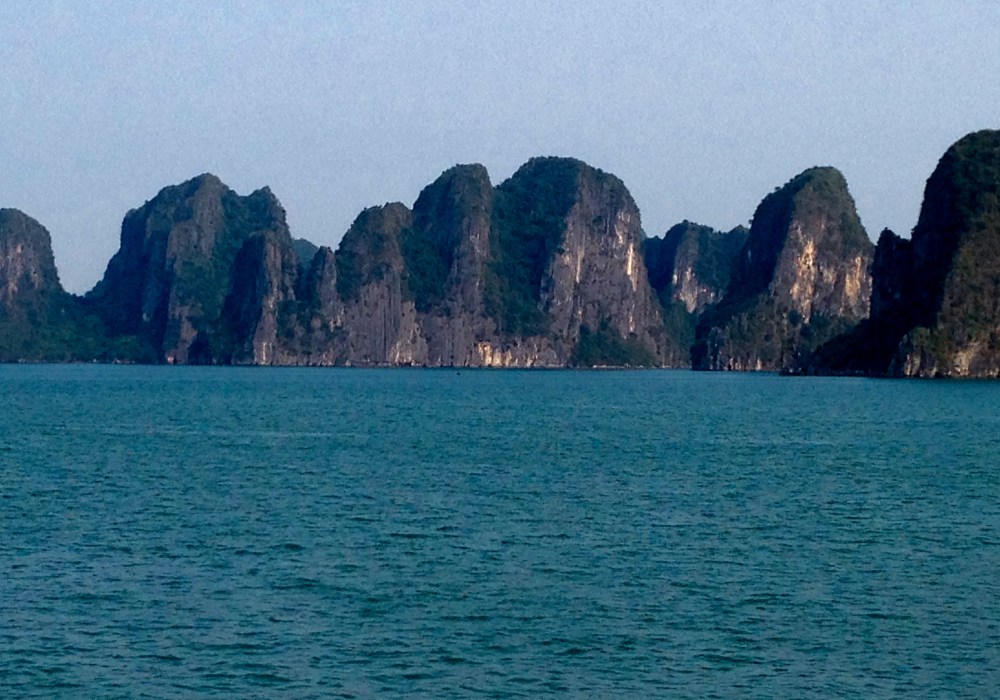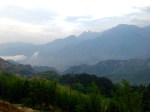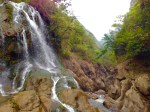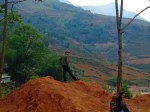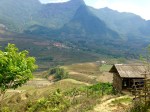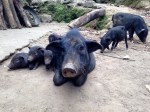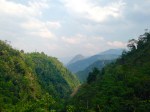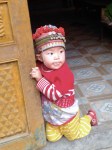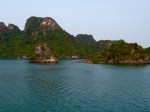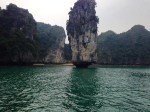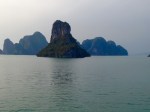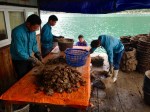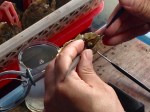Greetings from the future!
This dispatch comes to you from two popular Vietnam tourist destinations: Sapa and Halong Bay.
First, Sapa:
After two days in Hanoi, we set off for the mountain town of Sapa in northwestern Vietnam near the Chinese border. A very comfortable overnight train — quite contrary to our Shanghai to Hong Kong experience — took us from Hanoi to the town of Lao Cai, from which we took an hour shuttle bus to Sapa. The town of Sapa is quite small and tourism is hyper focused on appealing to Western travelers, as we will come to learn is the case for most travel destinations in Vietnam where the tourism industry is a well-oiled machine. The main street is lined with restaurants offering Western food, including an abundance of Italian pizzerias each with drool-inducing photos of pizzas on the menu and signs professing “the best pizza in Sapa,” one after another, but don’t be surprised when what arrives at your table doesn’t look like the photo. Western food is tricky in the East. You try to avoid the temptation because you know 9 times out of 10 you’ll be disappointed, but sometimes you want pizza so freaking bad, you make the leap of faith. In Sapa our pizza attempt left a lot to be desired.
So my point, stick to the Vietnamese cuisine in smaller towns. In big cities like Hanoi and Ho Chi Minh City, it’s a different story. Speaking of Vietnamese food, it was a welcome change from Chinese food. Don’t get me wrong, there were many Chinese dishes that delighted my palate, but if I had one request of Chinese food in general, it would be, “easy on the grease.” Everything is deep-fried, stir-fried, double-fried … the amount of cooking oil used in the country could fill an ocean. So, Vietnam’s fresh, light, seemingly healthy approach to cooking was refreshing. Ingredients like lemon grass, chili peppers and fish sauce are incorporated into many dishes. And pho, the most popular Vietnamese dish stateside, is actually consumed at breakfast in Vietnam. You can purchase a bowl from any street food vendor for about 15,000 to 30,000 Vietnamese Dong, approximately $0.50 to $1.50. Additionally, bánh mì just means bread, specifically baguettes, and can indicate any type of sandwich. As Chris mentioned in his introductory post, Vietnam was ruled by the French for a century, and the French influence today is still recognizable in the country’s cuisine and coffee culture.
Now back to Sapa …
Sapa is a top tourist attraction in Vietnam with sought after treks to the top of Fansipan, the highest mountain in Vietnam and all of Indochina at 10,312 ft., or through rice paddies and into local villages, where you can stay with a family from the village for the night. Vietnam is home to about 54 ethnic groups — the large majority, more than 86%, being ethnic Viet or Kihn. The majority of the remaining ethic groups live in the interior mountainous highlands.
Chris and I decided to do the two-day/one-night trek taking us through rice paddies and three villages, a H’mong, Red Dao and Tay village in that order, which included spending the night in the home of a Red Dao family. A distinguishing fashion of the Red Dao women is their red head scarves and shaven eyebrows. This is a photo of the family that we stayed with — the woman on the far right is in traditional dress and the baby girl is wearing a traditional hat made by her mother:
Joining us on our trek was an all-star backpacker group, including a soldier in the British Army, A Muay Thai boxer from Seattle, an Italian, a Spaniard and a Frenchman. Chris and I had a blast with our five new friends, and the family that we stayed with was extremely kind. They prepared a delicious and elaborate meal for us and generously indulged us in their homemade rice wine, which made day two of the hike extremely difficult for all of us in the group.
Here are some photos from our trek:
Next, Halong Bay:
After our trek in Sapa, we headed back to Hanoi, and then from Hanoi we organized a three-day/two-night trip to Halong Bay in the Gulf of Tonkin. Halong translates as “descending dragon”, and refers to a legend claiming that during ancient times, when Vietnam was newly formed, dragons descended from the heavens to help the Vietnamese people fight invaders from the North. This legend accounts for the mythical origin of the nearly 2,000 islands in Halong Bay. According to the legend:
“While the mighty enemies were attacking the main land, The Mother Dragon and her children suddenly appeared and incinerated the enemies with their divine fire and giant emeralds. The emeralds from the dragon’s mouth were scattered around the battlefield on the sea and formed an invincible defensive wall that left the enemy battleship fleet sinking. Thanks to the dragons, the Northern invaders were finally swept away and the peace finally came back to the South East Asian country once again. After thousands of years, the wall of emeralds turned into islands and islets of different sizes and shapes.”
The limestone rock formations pierce through the sea’s aqua blue surface making for a dramatic landscape of seemingly mythical quality. Our tour included one night on a boat and one night in a bungalow on Cat Ba Island. We also visited a pearl farm where we learned that a single plastic sphere is inserted into each clam to increase the production of viable pearls and accelerate their formation. The pearl develops around the artificial center.
Its unparalleled natural beauty made Halong Bay an unforgettable experience. Here are some photos from our trip:
Stay tuned for more from Vietnam!
